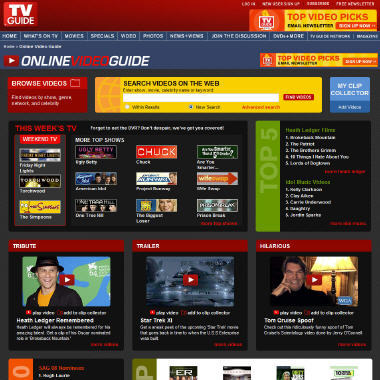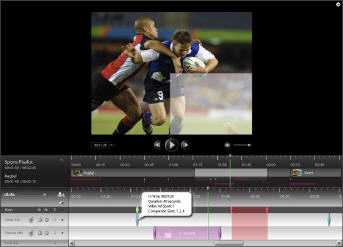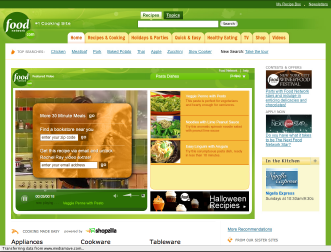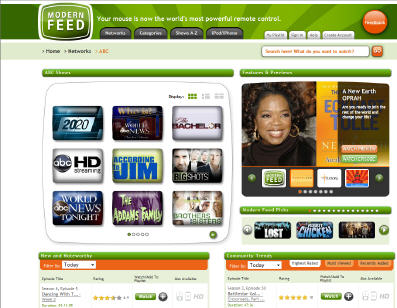-
3 Ways Binge-Watching is Changing the TV Game
Tuesday, January 20, 2015, 8:42 AM ETPosted by:In early September, my 11-year-old son filled out a get-to-know-you school questionnaire, listing his favorite things - tigers, the color orange, and...binge-watching.
My boy, who dove deep during summer break into Alphas (originally on Syfy, now on Netflix, highly underrated), has tons of company. More than 75% of TV Guide users say they binge-watch regularly. Remarkably, a behavior for which we didn’t even have a name a few years ago is now an exploding mass-market consumer habit that is changing the TV game - and benefitting both consumers and entertainment companies - in three major ways:Categories: Binge-viewing
Topics: Amazon, CBS, Netflix, TV Guide
-
Study: Ads in Short-Form Video More Effective Than Those in Long-Form
Advertisers and content providers continue to grapple with how to optimize ads in online video, and contributing to the dialogue, this morning AOL is releasing research indicating that ads in short-form videos are more effective than ads in long-form. Based on research involving 800 participants, AOL and its research partner Qualvu found that ads in short-form video had a 25% higher brand recall, produced 42% higher purchase intent and were 26% more likely to be liked. Short-form video is defined as less than 10 minutes with long-form 10 minutes or longer.
Categories: Advertising
Topics: AOL, FreeWheel, TV Guide
-
Research: 66% of Video Streamers "Hate" Mid-Roll Ads [VIDEO]
Most viewers know that ads are what pay the freight and so they're inevitable. But that doesn't mean they have to like them. At June's VideoNuze Online Video Advertising Summit, TV Guide.com's EVP & GM Christy Tanner presented the company's latest research, drawn from its panel of 10,000 online users, which showed that 66% of respondents "hate" ads during streaming videos (so-called "mid-rolls"). The hate rate for pre-rolls was 35% and for post-rolls, 32%. That possibly led to a 56% jump in paid streaming from Spring 2011 to Spring 2012.
Despite this, recent research from FreeWheel showed that even with higher ad loads and the increasing prevalence of mid-rolls, completion rates for both content and ads were up in Q2.
Christy also noted that 73% of respondents streaming TV shows do so to catch up on missed episodes and 40% for shows discovered mid-season or between seasons, while just 6% do so to cut back on cable. However, the research also showed that 5% cancelled cable. Lots more in Christy's presentation below.Categories: Advertising
Topics: TV Guide
-
TV Guide Updates Watchlist App With Social Features and New Video Sources
TV Guide has updated its Watchlist app, further bolstering its position as a one-stop hub for TV viewers' to track and manage their digital entertainment interests. Watchlist continues to present a very simple UI where users can add programs about which they want viewing information from lists of choices or through searching by shows and now also by sports teams and celebrities.
In addition to the linear schedule, Watchlist provides info from 120 different online sources (Hulu, Netflix, etc.) and now also on-demand and DVD information (note Comcast is the first pay-TV operator to provide on-demand data, but others will follow). All of this makes Watchlist a destination to quickly scan what's on, when and where. Below is a simple Watchlist I created in minutes.
Categories: Video Search
Topics: TV Guide
-
Modern Feed Jumps Into Video Navigation Space
With the proliferation of available broadband video comes a massive user navigation challenge. Modern Feed is launching today to address this. It is part search engine, part aggregator, with a specific focus on indexing professionally-produced programming, not user-generated video. It's also focused on actual programs, not promotional clips.
J.D. Heilprin, Modern Feed's founder/CEO told me yesterday that the company is targeting mainstream users providing the easiest way to find available, high-quality video. It employs a team of "Feeders" charged with curating the best videos to include on the site. The result is approximately 550 "networks" and 25,000 pieces of content now indexed, where "networks" is a loose term ranging from traditional broadcasters to indies new entrants like Boston Symphony or Architectural Digest.
Modern Feed is rights-holder friendly, not indexing any illegal or pirated video, and playing the video from the source's site (though sometimes with a thin Modern Feed navigation frame at the top of the screen). I played around with Modern Feed and found it to be easy-to-use and well-laid out. Modern Feed also offers an iPhone implementation that looks pretty cool, other devices are to follow.
The big challenge (and opportunity) for Modern Feed is that it's entering a very noisy space where user behavior is very undefined. There are myriad video search engines (Truveo, ClipBlast, blinkx, Veveo), portals (AOL, Yahoo, MSN), navigation sites (TV Guide, recently-launched PrimeTime Rewind) and of course the networks' own sites (and syndication efforts) offering users the ability to quickly find quality content. Then there's YouTube, the first stop for many users when it comes to video. And YouTube is increasingly moving up market by striking partnerships with premium providers.
Modern Feed's strong user experience, focus on mainstream users and device integrations are differentiators for the company. Whether these are ultimately success factors really depends on how user behavior unfolds in the nascent video navigation space. Modern Feed has raised several million dollars from angels and has 30 full-timers with aggressive growth planned.
What do you think? Post a comment and let everyone know!
See prior posts:
YouTube, C-SPAN Team Up for User-Generated, Multi-Platform Voter Project
Categories: Startups, Video Search
Topics: AOL, Blinkx, ClipBlast, Modern Feed, MSN, PrimeTime Rewind, Truveo, TV Guide, Yahoo, YouTube
-
TV Guide: The TV Guide of Broadband Video
Some brands are so ubiquitous that they become the touchstone reference point for others that follow. TV Guide is such a brand. With broadband video choices exploding, many companies would love to become the "TV Guide of the broadband era."
Well it turns out that TV Guide itself wants to be the TV Guide of the broadband era. The company's Online Video Guide (OVG), launched in April '07, shows that it is quite serious about morphing its brand as the
 boundaries between TV and broadband continue to blur. Recently I caught up with Christy Tanner, who is TVGuide.com's VP of Marketing and Editor-in-Chief to learn more.
boundaries between TV and broadband continue to blur. Recently I caught up with Christy Tanner, who is TVGuide.com's VP of Marketing and Editor-in-Chief to learn more.The key to understanding OVG's approach is that it not another pure algorithmically-driven video search engine. Rather, TV Guide is leveraging the company's strong editorial capability. First, it selectively chooses which video sites to index. Then it organizes/exposes the results in a way that makes sense to users, particularly those in the mainstream. It is also mixing in its own editorial content to give further context to the videos themselves.
A visit to OVG shows that it puts access to networks' programs front and center, along with a prominent search bar. Christy explained that TV Guide has learned users' strong affinity for programs, not networks, is driving their search/discovery behavior. Clearly OVG's growth is intertwined with the surging interest in accessing programs online.

OVG serves up results in both grid and list formats, with relevant metadata exposed. Conveniently, OVG has a tab for "Full episodes" and "Clips". If you click on "Full episodes", it will either display the choices or simply say "We did not find any videos matching your search" when the network hasn't made full episodes available (such was the case for "Mad Men", AMC's new hit, whose last 2 episodes I missed, and have been searching for ever since).
OVG shares its own top picks, top 5 and 10 lists, provides a launch point to purchase programs, and highlights certain celebrities (currently Britney Spears, to nobody's surprise...). It also offers an e-newsletter, the Online Video Daily Scoop, with lots of highlights. OVG now indexes over 60 video sites, with videos from 25,000 shows, movies and celebrities, adding up to a total index for 200,000+ videos.
Another smart thing about TV Guide's strategy for OVG is that it is putting a big push behind syndicating the product. It can syndicate the entire experience, just the front end, or the full data set. This leads to a mix of revenue streams - advertising, licensing and hybrids.
There is no shortage of startups and others who are bent on capturing brand supremacy in the broadband video navigation space. Credit to TV Guide. It's defending its incumbency with an aggressive, user-centric game plan.Categories: Video Search
Topics: TV Guide
-
5 Observations from My Digital Hollywood Panel
 Yesterday I moderated a spirited panel at Digital Hollywood. Panelists included:Rebecca Baldwin -GM, Zap2it, Tribune Media ServicesJonathan Bokor - VP, Business Development, Tandberg TelevisionDave Brown - Senior Product Marketing Manager, CiscoRich Cusick - SVP, Digital Media, TV GuideBob Leverone - VP, Television, Dow JonesRex Wong - CEO, DAVE Networks
Yesterday I moderated a spirited panel at Digital Hollywood. Panelists included:Rebecca Baldwin -GM, Zap2it, Tribune Media ServicesJonathan Bokor - VP, Business Development, Tandberg TelevisionDave Brown - Senior Product Marketing Manager, CiscoRich Cusick - SVP, Digital Media, TV GuideBob Leverone - VP, Television, Dow JonesRex Wong - CEO, DAVE NetworksI had 5 observations from the discussion:
1. Broadband video is making its mark - From the panelists' intros, it was clear that these companies are all being impacted by broadband. For example, Cisco used to be all about IP, now "video networking" is driving growth, Dow Jones used to be all about print, now it's creating high-quality original video for multimedia experiences, TV Guide used to be about print and cable, now it has significant online video guide. Broadband's impact is poised to grow further.2. With video proliferation, navigation is key challenge - panelists agreed that users' ability to find what they're looking for in the sea of broadband video is a huge issue. Both TV Guide and Zap2it are focused mainly on TV/entertainment content for now, question arises, will there be a one-stop guide destination for all broadband video (TV, films, short form, UGC, news, etc.)? Nobody owns that position right now, so who is best-positioned to fill that role?
3. Broadband video must be more than just TV - Jonathan made the point most strongly, and others agreed. For broadband to succeed it must do more than just be another medium for delivering existing TV programs. Sure, there's a rush to get broadcast TV shows online, but only real innovation will distinguish broadband from me-too TV delivery. Here, here. I've been preaching that for ages. Broadband offers a whole new creative palette to harness.
4. Cable operators wary of broadband video - no big surprise here, but Dave made it clear that major cable operators are wary of broadband and are focused on retaining as much control of the video experience as possible. For example, I asked what the roadmap looked like for cable operators to enable users to watch YouTube videos (and other broadband-only fare) on their TVs through cable set-top boxes, and if I understood Dave's response correctly, it sounds like no time soon. Quality, liability, and of course control are key limitations. If cable's not going to bring broadband to the TV anytime soon, might that open the door for third-party boxes?
5. WGA strike could drive more broadband projects - Rich speculated that a byproduct of a potential WGA strike and writers sitting around would be that maybe more broadband projects would be undertaken. Hard to predict, but there's certainly plenty of interest in broadband-only production, so my guess is writers wouldn't have a problem finding opportunities. Wouldn't it be ironic if the potential strike, which has new media compensation at its core, actually spurred more broadband video?
Categories: Events
Topics: Cisco, DAVE Networks, Digital Hollywood, Dow Jones, Tandberg, Tribune, TV Guide, Zap2it
-
Maven Moves the Broadband Video Ad Market Forward
Maven Networks got a lot of ink today with 2 announcements, first the launch of a new broadband ad platform and the second, the launch of a new industry collaboration dubbed the "Internet TV Advertising Forum." These have been in the works for a while and Maven gave me a heads up on both over the summer.
The Ad Forum is noteworthy, as it appears to be a genuine "good guy" effort to move the whole industry forward in optimizing the ad model. Ten companies signed on for launch, including heavies like Scripps, Fox News, Oglivy, TV Guide, Microsoft, DoubleClick and 24/7.
I caught up by phone with Kristen Fergason, Maven's VP of Marketing to learn more. First, the Forum is completely open to everyone. Though initially underwritten by Maven, over time it will probably take on more of a "dues-paying" model. And to show that "open" really does mean open, I asked what happens if competitors like Brightcove for example, wanted in? Her reply: "we'd happily accept them".
The forum is mean to bring together agencies, content providers and vendors to build consensus about how to move past the market's current reliance on pre-rolls. Kristen said industry players have been "chomping at the bit" to get involved and Maven received 40 applications today alone. Importantly, the Forum is meant to augment IAB initiatives, not compete with them. The Forum will run focus groups and collect research based on ideas generated by Forum members to see what works and what doesn't. Results will be available to everyone.
Maven believes that a "rising tide lifts all ships", but because its ad platform is ready now, it will benefit disproportionately. That's where today's other announcement comes in. The demo I saw shows how new ad units (videos, overlays, banners, etc.) can be dynamically inserted, not just at the beginning of the video, but throughout. The result is that a lot of new inventory is available. The below graphic shows "cue points" for manual insertion, but an algorithm can also be used to insert based on what the system knows about things like clip length, average user session time, click-thru, etc. Note I didn't see this feature in action, so I can't say for sure how well it actually works.
 There's also pretty neat telescoping transaction capability as shown below, which allows the content provider or advertiser to collect specific user information. The video resumes when the user is done.
There's also pretty neat telescoping transaction capability as shown below, which allows the content provider or advertiser to collect specific user information. The video resumes when the user is done. The ad platform looks like a solid entry and when taken together with other myriad ad initiatives in the market, everything suggests that we may actually see life beyond pre-rolls. Hallelujah.
The ad platform looks like a solid entry and when taken together with other myriad ad initiatives in the market, everything suggests that we may actually see life beyond pre-rolls. Hallelujah.Categories: Advertising, Technology
Topics: 24/7, Brightcove, DoubleClick, Fox News, Maven, Microsoft, Oglivy, Scripps, TV Guide
Posts for 'TV Guide'
|




